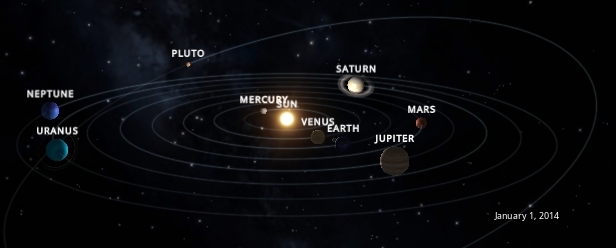Night sky guide for January 2014

-
January 1 – New Moon – 11:14 UTC. The Moon will be directly between the Earth and the Sun and will be completely unilluminated.
-
January 2, 3 – Quadrantids Meteor Shower peak nights. The Quadrantids have the potential to be the strongest shower of the year but usually fall short due to the short length of maximum activity (6 hours) and the poor weather experienced during early January. The average hourly rates one can expect under dark skies is 25. These meteors usually lack persistent trains but often produce bright fireballs. Due to the high northerly declination (celestial latitude) these meteors are not well seen from the southern hemisphere. The shower is thought to be produced by dust grains left behind by an extinct comet known as 2003 EH1. The thin crescent moon will set early in the evening leaving dark skies for what could be an excellent show. Best viewing will be from a dark location after midnight. Meteors will radiate from the constellation Bootes, but can appear anywhere in the sky. (AMS, SeaSky). Read more…
-
January 3 – Mars at aphelion – 00:24 UTC. Mars is at its furthest point to the Sun.
-
January 5 – Jupiter at opposition – 21:01 UTC. Jupiter will be at its closest approach to Earth and brightest in the sky for the year. This is the best time to observe it with binoculars and telescopes.
-
January 11 – Venus at inferior solar conjunction – 12:19 UTC. From our vantage point on the Earth,Venus will appear to pass around the near side of the Sun, almost crossing between the Sun and us. As it does so, it will pass within a mere 05°11' of it in the night sky and becoming totally lost in its glare.Over the next few days Venus will be approaching its closest position to the Earth but will be completely unilluminated. At perigee it will be moving at a distance of about 0.27 AU from the Earth (40 391 425 km), but it will be completely unilluminated. If it could be observed, it would measure 62.7 arcsec in diameter. Venus's reaching inferior conjunction marks the end of its apparition in the evening sky and its transition to become a morning object over the next few weeks. (In The Sky)
-
January 15 – Conjunction between the Moon and Jupiter – 04:49 UTC. The Moon and Jupiter will make a close approach – within 4°51' of each other. They will be visible for much of the night – in the east in the early evening, and in the west in the pre-dawn sky. At the moment of closest approach, the Moon will be at mag -12.5, and Jupiter at mag -2.7, both in the constellation Gemini. They will be visible to the naked eye or through a pair of binoculars. Read more…
-
January 16 – Full Moon – 04:54 UTC. The Moon will be directly opposite the Earth from the Sun and will be fully illuminated as seen from Earth. This phase occurs at 04:52 UTC. This full moon was known by early Native American tribes as the Full Wolf Moon because this was the time of year when hungry wolf packs howled outside their camps. This moon has also been know as the Old Moon and the Moon After Yule. (SeaSky)
- January 25 – Conjunction between the Moon and Saturn – 13:48 UTC. The Moon and Saturn will make a close approach, passing within 0°33' of each other. will be a little too widely separated to fit comfortably within the field of view of a telescope, but will be visible to the naked eye or a through pair of binoculars. Read more…
-
January 30 – New Moon – 21:40 UTC. The Moon will be directly between the Earth and the Sun and will be completely unilluminated. Best time for observing and photographing.

Whats up for January 2014 – Video courtesy NASA JPL


Tonight's Sky: January 2014 – Video courtesy Hubble Space Telescope
Sky & Telescope's SkyWeek – January 2014 – Video courtesy Sky & Telescope
Featured image: Solar System Scope. Edit: The Watchers

Commenting rules and guidelines
We value the thoughts and opinions of our readers and welcome healthy discussions on our website. In order to maintain a respectful and positive community, we ask that all commenters follow these rules.